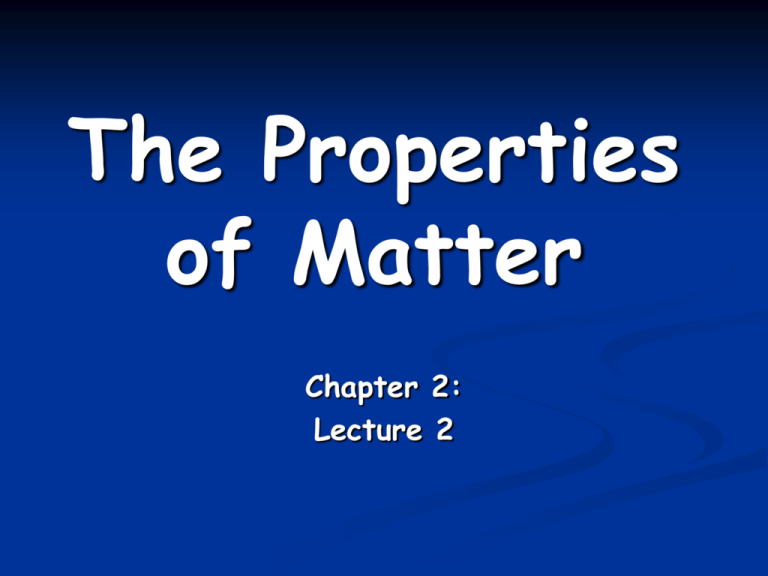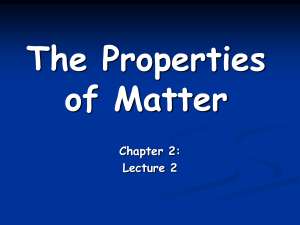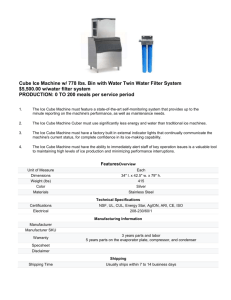PowerPoint Presentation - The Properties of Matter
advertisement

The Properties of Matter Chapter 2: Lecture 2 V is for Volume Briefly, volume is the amount of space something takes up. Whether it’s a speck of dust or Jupiter, all matter takes up space. Measuring the volume of… Liquids: Graduated cylinder Displacement method Measured in liters (L) & milliliters (mL) Solids: Length x width x height Gases: Since a gas expands to fill its container, if you know the volume of the container, you know the volume of the gas. 4. Reading the Meniscus QuickTime™ and a decompressor are needed to see this picture. 5. Displacement Method for Volume QuickTime™ and a decompressor are needed to see this picture. Density - The mass of a substance divided by its volume Density is an important physical property. Density is the mass of a substance per unit volume. Volume is the amount of space an object occupies. Extensive - Properties that do depend on the amount of matter present. Volume A measurement of the amount of space a substance occupies. *Length 5. Eureka!! Volume & Density QuickTime™ and a decompressor are needed to see this picture. You try it! How can you describe them if you didn't know what they were? Describing objects by using size shape color texture uses an object's properties. We call ‘em Properties It doesn’t matter what your object was, everyone used similar descriptions. What were some of the properties you listed about your object? Size, Weight & Mass, Shape, Odor, Sound, etc. After opening your bag, you were able to list even more properties such as color, texture, etc. Physical properties Physical properties can be observed or measured without changing the identity of the matter. Basically, properties you notice when using one of your five senses: Feel - mass, volume, texture Sight - color Hear Smell Taste Physical properties of matter are categorized as either: Intensive or Extensive: Intensive - Properties that do not depend on the amount of the matter present. Color Odor Luster - How shiny a substance is. Malleability - The ability of a substance to be beaten into thin sheets. Ductility - The ability of a substance to be drawn into thin wires. Conductivity - The ability of a substance to allow the flow of energy or electricity. Hardness - How easily a substance can be scratched. Melting/Freezing Point The temperature at which the solid and liquid phases of a substance are in equilibrium at atmospheric pressure. Boiling Point - The temperature at which the vapor pressure of a liquid is equal to the pressure on the liquid (generally atmospheric pressure). More Physical Properties Density is a very important property. It is the amount of matter in a given volume. Density = Mass / Volume Properties of all objects Objects take up space. All objects take up space. Your computer is taking up space on the desk. You are taking up space on the chair. Properties of Matter Remember all objects take up space and have mass. You use your sense of taste and smell to tell the difference between spinach and an orange. Physical properties The measurement of mass and other characteristics that can be seen without changing how that object looks are its physical properties. When you look at oranges, you know that they are oranges because of their color, shape, and smell. Mass, color, shape, volume, and density are some physical properties. The answers to the question about the present are physical properties. Properties of Matter A property describes how an object looks, feels, or acts. The objects shown here have different kinds of properties: Physical properties- Properties are constantly changing... Matter is constantly changing. Ice in your soda melts, glass breaks, paper is ripped. When ice in your soda melts where does it go? What does it become? Physical vs. Chemical Physical properties: observe without changing the identity of the substance Chemical properties: observe only when the identity changes How do you know if it is chemical or physical? If it CHanges, it’s CHemical Chemical properties A common chemical property is reactivity. Reactive to oxygen Reactive to air Reactive to water… Notice that chemical properties aren’t EASY to observe, unlike physical properties. Physical Changes: Changes in matter that do not alter the identity of the matter itself. Physical Changes Changes that do NOT change the identity of the substance. You may or may not be able to undo a physical change. Physical Changes: For example: 1. Size 2. Shape 3. State - solid liquid gas 4. Dilutions The water doesn't turn into soil or macaroni. It remains water. If it did change into soil or macaroni, your drink would taste terrible and you would have an example of a chemical change If you remember, ice is water in the solid state. When you drop the ice cube into the liquid, it begins to melt because the temperature is higher than that of the ice cube. It's like putting a snowman on your front lawn in July. The ice cube becomes liquid water. This is an example of a physical change. The solid water turned to liquid water. Chemical Changes Chemical changes do alter the identity of a substance In other words, a chemical change is when something changes into an entirely different substance For example: Iron rusting Wood burning Copper turning to brass Baking a cake spoiled milk Chemical properties These are properties that can only be observed by changing the identity of the substance. A piece of paper burns and turns to a black substance. After the flame goes out you can no longer burn the new substance. The chemical properties have been changed. Milk needs to be in the refrigerator or else it will go bad. If you've ever seen or smelled spoiled milk, it is not a pretty sight. The milk gets a sour odor and becomes lumpy. Unlike physical changes, you cannot reverse chemical changes. You can melt ice to get water and freeze that water to get ice again. You cannot make milk unspoiled. Brainpop Property changes! Common Errors *Ice melting, water freezing, water evaporating, and steam condensing are all examples of a state change. *These are physical changes, not chemical. *Diluting a solution is a physical change, even if the color becomes more faint. The Take Home Message State changes, like melting, freezing, boiling, are all PHYSICAL changes. The substance remains the same substance, it just changes what STATE it is in. We’ll talk about this next time.





